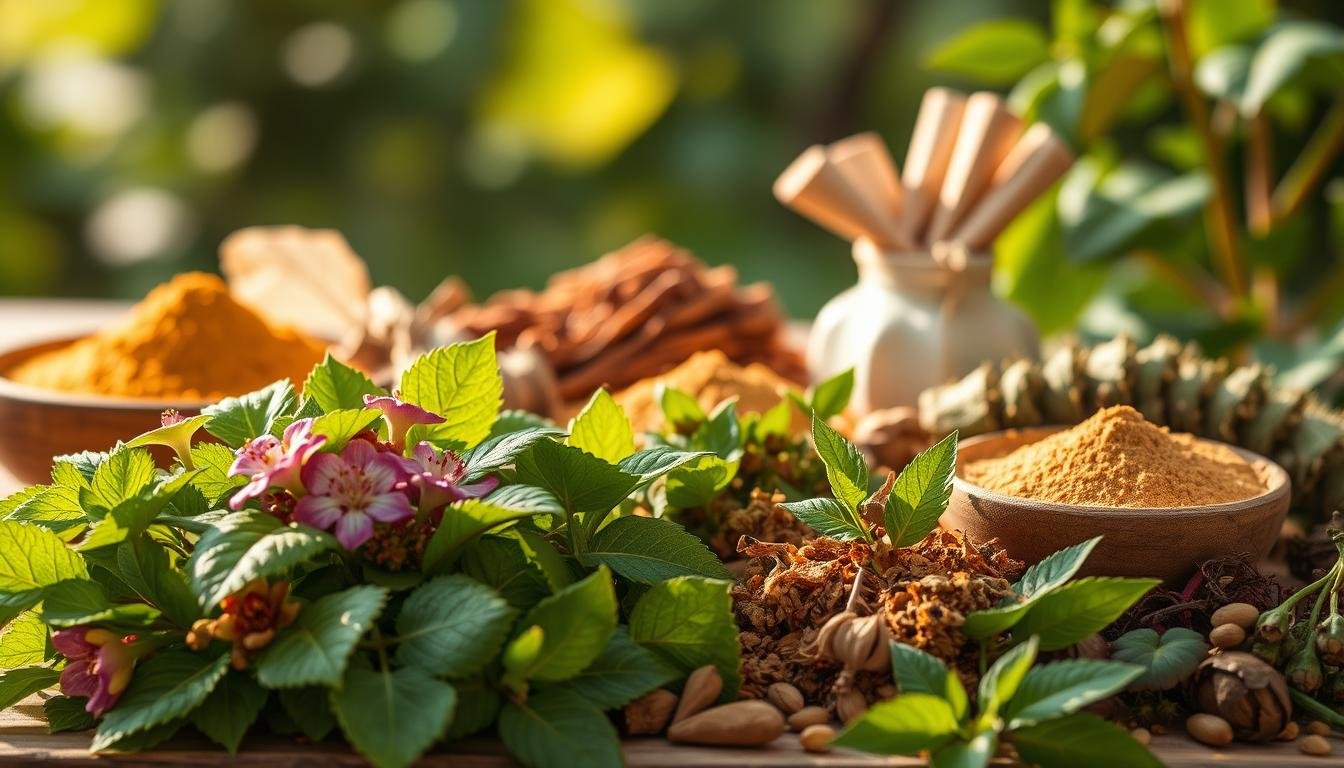In today’s fast world, stress is common. But, there’s a simple way to ease it: spending time in the forest. This practice, called Shinrin-Yoku or forest bathing, boosts both mental well-being and health.
By slowing down and connecting with nature, you can enjoy its healing effects. This article will dive into forest bathing, its stress-reducing benefits, and how to add it to your life.
Key Takeaways
- Discover the concept of Shinrin-Yoku and its benefits.
- Learn how nature therapy can reduce stress.
- Understand the importance of slowing down in nature.
- Find out how to incorporate forest bathing into your routine.
- Explore the positive impact on mental well-being.
What is Forest Bathing (Shinrin-Yoku)?
Shinrin-Yoku, or ‘forest bathing,’ is a mindful practice from Japan. It focuses on the health benefits of nature. It’s more than just walking in the woods; it’s about fully experiencing the forest to find calm.
The Origins of Shinrin-Yoku
In the 1980s, Japan started Shinrin-Yoku to fight urban stress. The Japanese Ministry of Agriculture, Forestry, and Fisheries created the term. They wanted to show how forests can heal us.
The Science Behind the Term
Studies show Shinrin-Yoku is good for our health. It can lower stress hormones and improve mood. The natural world helps our bodies relax.
Key benefits of Shinrin-Yoku include:
- Reduced stress levels
- Improved mood and cognitive function
- Boosted immune system
- Increased sense of calm and relaxation
Cultural Significance in Japan
In Japan, Shinrin-Yoku is a big part of the culture. It’s practiced in many forests. It’s seen as a way to stay healthy and connect with nature.
Learning about Shinrin-Yoku’s origins and benefits helps us see its value. It shows how it can improve our lives.
The Benefits of Forest Bathing
Forest bathing is great for your mental and physical health. It lets you enjoy nature’s benefits, improving your overall well-being.
Reducing Stress and Enhancing Relaxation
Forest bathing is amazing for lowering stress and helping you relax. Studies show it can reduce cortisol, heart rate, and blood pressure. These are signs of stress.
Relaxation Techniques like deep breathing, mindfulness, and meditation help you feel calm and relaxed.
Boosting the Immune System
Forest bathing also boosts your immune system. It increases natural killer cells, which fight infections and diseases.
Improving Mood and Mental Clarity
It’s also good for your mood and mental clarity. Being in nature can reduce anxiety and depression, making you feel happier and more focused.
The calming effects of nature help clear your mind. This improves your focus and concentration.
Fostering a Connection to Nature
Forest bathing helps you connect with nature. It engages your senses, making you appreciate and feel a part of nature.
| Benefits | Description | Impact |
|---|---|---|
| Stress Reduction | Lower cortisol levels, reduced heart rate | Enhanced relaxation and calm |
| Immune System Boost | Increased natural killer cell activity | Better defense against infections and diseases |
| Mood Improvement | Reduced symptoms of anxiety and depression | Improved mental well-being and happiness |
How to Practice Forest Bathing
Forest bathing is more than just walking in the woods. It’s about fully immersing yourself in nature. This practice, known as Shinrin-Yoku, uses your senses to relax and feel well.
Finding the Right Location
To start forest bathing, find a quiet spot. This could be a forest, a park, or any area with lots of plants. Choose a place where you can really connect with nature.
Look for a spot with easy walking trails. This makes forest bathing more enjoyable. Use online resources or local guides to find the best places near you.
Tips for Immersive Experiences
To get the most from forest bathing, be fully present. Here are some tips to help:
- Slow down and take deep breaths.
- Use all your senses: see, hear, smell, and touch.
- Leave your phone behind to avoid distractions.
- Focus on the moment to practice mindfulness.
Clothing and Gear Essentials
Wearing the right clothes is key for a good forest bathing experience. Wear comfy clothes and shoes that are good for walking. Bring extra gear like a raincoat or sunscreen based on the weather.
Don’t forget to bring water to stay hydrated. Some people also carry a small backpack with a first-aid kit, snacks, and a map.
| Essential Items | Description |
|---|---|
| Comfortable Clothing | Choose clothes that allow for ease of movement. |
| Sturdy Shoes | Select shoes that are suitable for walking on various terrains. |
| Water Bottle | Stay hydrated during your forest bathing experience. |
| First-Aid Kit | A basic kit can be useful for minor injuries. |
The Role of Nature in Stress Relief
Modern life can be tough, and nature helps a lot. It offers many benefits that ease our daily stress. This leads to a calm and happy feeling.
Nature’s Impact on Mental Health
Nature greatly affects our mental health. Studies show it can lessen anxiety and depression. Shinrin-Yoku, or forest bathing, is a great way to enjoy nature’s benefits.
Key benefits of nature on mental health include:
- Reduced stress levels
- Improved mood
- Enhanced cognitive functioning
Restorative Environments
Restorative environments help us recover from stress. They are natural or designed to calm our minds. These places capture our attention in a gentle way.
Characteristics of restorative environments include:
- Fascinating scenery or elements that capture attention
- A sense of being away from daily routines and stressors
- Compatibility with one’s preferences and needs
- Extent or scope, providing a sense of vastness or immersion
How Colors and Sounds Affect Us
The colors and sounds in nature are key to its healing effects. For example, green spaces and water sounds can calm us down. They help reduce stress.
| Sensory Element | Effect on Stress Relief |
|---|---|
| Green spaces | Reduces eye strain and promotes relaxation |
| Water sounds | Creates a calming atmosphere, masking other distracting noises |
| Natural light | Regulates circadian rhythms, improving mood |
By understanding nature’s stress-relieving elements, we can use them daily. This improves our mental health and quality of life.
Engaging Your Senses
Engaging your senses can deepen your connection with nature. It makes forest bathing more effective at reducing stress. This practice helps you fully experience the forest’s therapeutic benefits.
Sight: Visual Elements of the Forest
The forest is full of stunning colors, textures, and patterns. You’ll see vibrant greens, earthy tree trunks, and dappled light. Take time to notice the details, like leaf shapes and tree bark patterns.
Being in nature can improve your mental health. It can reduce anxiety and depression. The forest’s visuals help you feel calm and well.
Sound: The Healing Power of Nature Sounds
The forest’s sounds are as therapeutic as its visuals. You’ll hear leaves rustling, birds chirping, and brooks babbling. These sounds help you focus on the present and practice outdoor mindfulness.
Listening to nature sounds can lower your blood pressure and stress levels. As you explore the forest, let the sounds guide you into relaxation.
Smell: The Aromatherapy of Trees and Plants
The forest is filled with scents, from damp soil to tree oils. Your sense of smell is linked to memory and emotions. Breathing in the forest’s air can be refreshing and uplifting.
Many trees, like pine and cedar, release oils with therapeutic benefits. As you walk, take deep breaths and let the scents enhance your forest therapy benefits.
Creating a Forest Bathing Routine
Starting a forest bathing routine can change your life for the better. It’s a way to improve your mental health by spending time in nature. This practice helps reduce anxiety and stress.
It’s not just about going to the forest sometimes. It’s about making it a regular part of your life. This way, you can really feel the benefits of being in nature.
Establishing a Regular Schedule
To get the most from forest bathing, you need a regular schedule. Pick a day each week or month to spend in nature. Being consistent helps your mental health in the long run.
Think about the best time of day and season for your forest baths. Early morning or late afternoon can be peaceful. Different seasons offer unique experiences, like spring flowers or winter snow.

Incorporating Mindfulness Practices
Forest bathing is more than just being outside. It’s about being mindful of your surroundings. Try deep breathing, meditation, or simply noticing the world around you.
There are many ways to practice mindfulness. For example, the “5-4-3-2-1” method helps you stay present. Notice five things you see, four things you touch, and so on.
Combining with Other Wellness Activities
Adding other wellness activities to forest bathing can make it even better. Try yoga, tai chi, or stretching exercises. These activities improve your physical health and connect you with nature.
For example, doing yoga in a forest can improve your balance. The natural setting adds a special touch to your practice, making it more enjoyable.
| Activity | Benefits | Tips for Combination |
|---|---|---|
| Yoga | Improves flexibility and balance | Choose a quiet spot with a flat surface |
| Tai Chi | Enhances mental clarity and relaxation | Practice slow movements, focusing on breath |
| Stretching Exercises | Increases flexibility and reduces stress | Start with gentle stretches, warming up gradually |
“Nature is not a place to visit. It is home.” – Gary Snyder
By making forest bathing a regular part of your life, you can greatly improve your mental health. It’s about choosing to prioritize your well-being and connect with nature.
The Community Aspect of Forest Bathing
Forest bathing doesn’t have to be solo. It has a strong community side that can make it even better. Being with others can add support and deepen your bond with nature.
Joining Local Forest Bathing Groups
Joining a local group is a great way to dive into forest bathing’s community side. These groups plan walks and activities in nearby forests. You’ll meet people who love nature and mindfulness just like you.
Being part of a group can make you feel supported and understood. You can share your experiences and learn from others. It’s a chance to build lasting friendships.
Guided Sessions and Their Benefits
Guided forest bathing sessions are great for beginners. A guide can show you around and teach you how to enjoy the experience fully. They can also teach you about local plants and animals.
Guided sessions also include mindfulness practices. These help you stay focused and relaxed. You’ll learn how to make forest bathing a regular part of your life.
Sharing Experiences with Friends and Family
Forest bathing is perfect for doing with friends and family. It’s a great way to spend time together and make memories. You can explore new places and enjoy nature’s beauty together.
Sharing forest bathing with others can also inspire them to try it. It’s a way to spread the joy of nature therapy. Whether it’s a family outing or a trip with friends, it’s a meaningful activity to share.
Challenges and Considerations
Forest bathing is a great way to relax, but it’s important to be aware of some challenges. Knowing your surroundings and potential issues can make your experience better.
Safety in Natural Environments
Safety is key when you’re in the forest. Watch out for the terrain, weather, and wildlife. Always tell someone where you’re going and when you’ll be back.
Here are some safety tips:
- Wear the right clothes and shoes for the terrain.
- Carry water, snacks, and a first-aid kit.
- Know your limits and health conditions.
Environmental Awareness and Conservation
Forest bathing helps you connect with nature. It’s important to respect and protect the environment. Stay on trails, don’t litter, and avoid disturbing wildlife.
Being eco-friendly helps keep nature beautiful for others. Here’s how you can help:
- Follow Leave No Trace principles.
- Support local conservation efforts.
- Teach others about environmental conservation.
Managing Expectations
Manage your expectations when you’re forest bathing. Everyone’s experience is different. Be patient and enjoy the moment.
Here’s how to get the most out of it:
- Be open to new experiences.
- Practice mindfulness and presence.
- Take time to reflect and relax.
Knowing these challenges can make your forest bathing better. It ensures a safe and enjoyable time.
| Consideration | Description | Tips |
|---|---|---|
| Safety | Being aware of your surroundings and potential hazards. | Wear appropriate clothing, bring necessary supplies, know your physical limitations. |
| Environmental Awareness | Respecting and protecting the natural environment. | Stay on trails, follow Leave No Trace, support conservation efforts. |
| Managing Expectations | Understanding the variable benefits and being patient. | Be open to new experiences, practice mindfulness, allow time for reflection. |

Conclusion: Embracing Nature’s Healing Power
Forest bathing shows us how nature can help our minds. It’s a way to reduce stress and feel better overall. By adding ecotherapy for anxiety to our lives, we can see big improvements.
Reaping the Rewards of Nature Therapy
Choosing nature’s healing power is good for us and our community. As cities get bigger, using nature therapy in urban planning is key. It greatly improves our mental health.
Urban Oases for Mental Wellness
Look for parks or green areas near you for forest bathing. Doing this not only helps you but also supports a healthier lifestyle. It shows the importance of nature in our lives.



